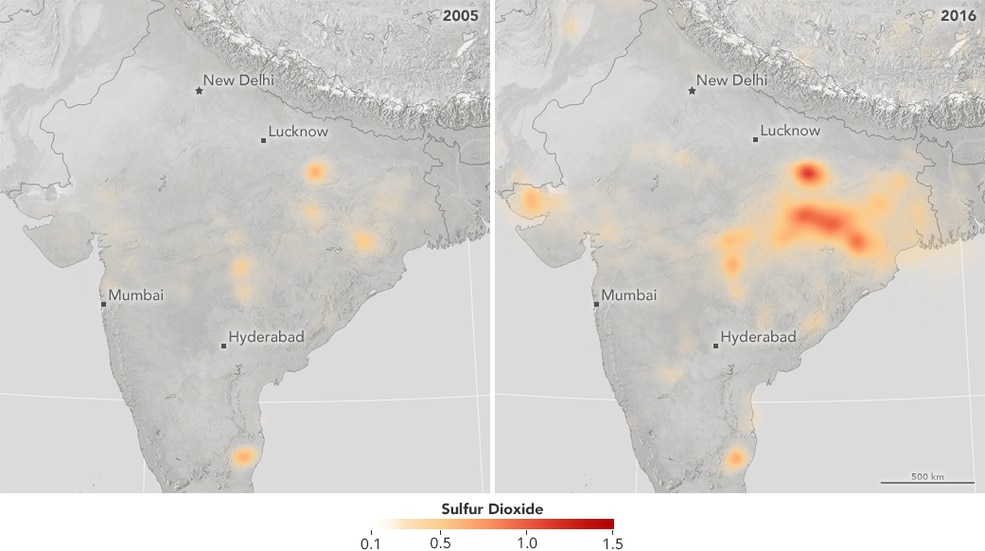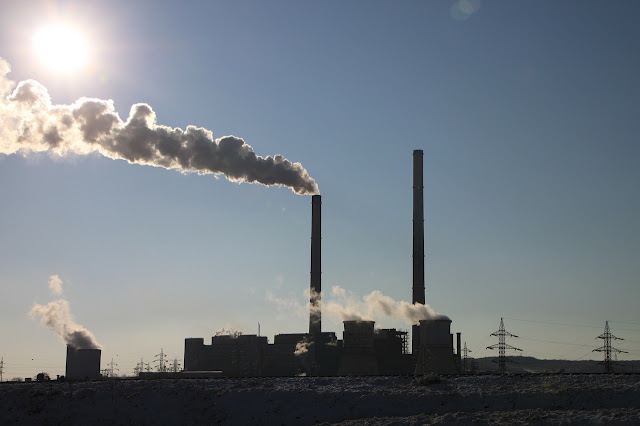Table of Contents:-
- Introduction
- What is Sulfur dioxide (SO2)?
- How does SO2 affect human health?
- Greenpeace report findings
- What are the reasons for India's high emission of SO2?
- Top Emitter Hotspots in India
- Major Hotspots in the World
- What is the Ozone Monitoring Instrument (OMI)?
- About Greenpeace:-
Introduction:-
India is the largest emitter of SO2 (Sulphur Dioxide) in the World, contributing more than 15 percent of global anthropogenic emissions, according to a Greenpeace report published on 19th August 2019. According to an analysis of a National Aeronautics and Space Administration (NASA) data released by environmental NGO Greenpeace on Monday, India has more than 15 percent of all anthropogenic sulfur dioxide (SO2) hotspots in the world detected by the OMI (Ozone Monitoring Instrument) satellite.
What is sulfur dioxide?
Sulfur dioxide is a gas. It reacts easily with other substances to form harmful compounds, such as sulfuric acid, sulfurous acid, and sulfate particles.
About 99% of the sulfur dioxide in air comes from human sources. The main source of sulfur dioxide in the air is an industrial activity that processes materials that contain sulfur, eg the generation of electricity from coal, oil or gas that contains sulfur. Some mineral ores also contain sulfur, and sulfur dioxide is released when they are processed. In addition, industrial activities that burn fossil fuels containing sulfur can be important sources of sulfur dioxide.
Sulfur dioxide is also present in motor vehicle emissions, as the result of fuel combustion.
How does sulfur dioxide affect human health?
Sulfur dioxide affects human health. It irritates the nose, throat, and airways to cause coughing, wheezing, shortness of breath, or a tight feeling around the chest. The effects of sulfur dioxide are felt very quickly and most people would feel the worst symptoms in 10 or 15 minutes after breathing it in. Those most at risk of developing problems if they are exposed to sulfur dioxide are people with asthma or similar conditions.
Greenpeace Report findings:-
The report said SO2 emissions are a significant contributor to air pollution. The largest source of SO2 in the atmosphere is the burning of fossil fuels in power plants and other industrial facilities.
In December 2015, the Ministry of Environment, Forest and Climate Change, had introduced for the first time SO2 emission limits for coal power plants with an initial deadline to retrofit technology to control SO2 emissions from power generation by December 2017.
At the request of the Ministry of Power and power plant operators, this was later extended till December 2019 for power plants in Delhi-NCR and till 2022 for some other power plants across the country through a Supreme Court order, the NGO said.
According to the analysis, air pollution is a huge public health concern, with 91 percent of the world's population living in areas where outdoor air pollution exceeds guideline limits by the World Health Organization (WHO) and as a result, 4.2 million people die prematurely every year.
What are the reasons for India's high emission of SO2?
India's high emission output is because of the expansion of coal-based electricity generation & Burning of fossil fuels in power plants. Other sources include industrial processes such as extracting metal from ore, natural sources such as volcanoes, and locomotives, ships and other vehicles and heavy equipment that burn fuel with high sulfur content.
Top Emitters Hotspots in India:-
The major SO2 emission hotspots in India are Singrauli in Madhya Pradesh, Neyveli and Chennai in Tamil Nadu, Talcher and Jharsuguda in Odisha, Korba in Chhattisgarh, Kutch in Gujarat, Ramagundam in Telangana and Chandrapur and Koradi in Maharashtra.

Major Hotspots in the World:-
The NASA data also highlights other hotspots across the globe, with the Norilsk smelter complex in Russia being the largest SO2 emission hotspot in the world, followed by Kriel in Mpumalanga province in South Africa and Zagros in Iran.

What is the Ozone Monitoring Instrument (OMI)?
The ozone monitoring instrument (OMI) is a visual and ultraviolet spectrometer aboard the NASA Aura spacecraft. OMI can distinguish between aerosol types, such as smoke, dust, and sulfates, and can measure cloud pressure and coverage, which provide data to derive tropospheric ozone
The OMI project is a cooperation between the Netherlands Agency for Aerospace Programmes (NIVR), the Finnish Meteorological Institute (FMI) and the National Aeronautics and Space Agency (NASA).
About Greenpeace:-
Greenpeace is a non-governmental environmental organization with offices in over 55 countries and an international coordinating body in Amsterdam, the Netherlands. Greenpeace was founded in 1971 in British Columbia to oppose U.S. nuclear testing at Amchitka Island in Alaska.
Greenpeace, an international organization dedicated to preserving endangered species of animals, preventing environmental abuses, and heightening environmental awareness through direct confrontations with polluting corporations and governmental authorities. It uses direct action, lobbying, research, and ecotage to achieve its goals. The global organization does not accept funding from governments, corporations, or political parties, relying on three million individual supporters and foundation grants.


Post a Comment